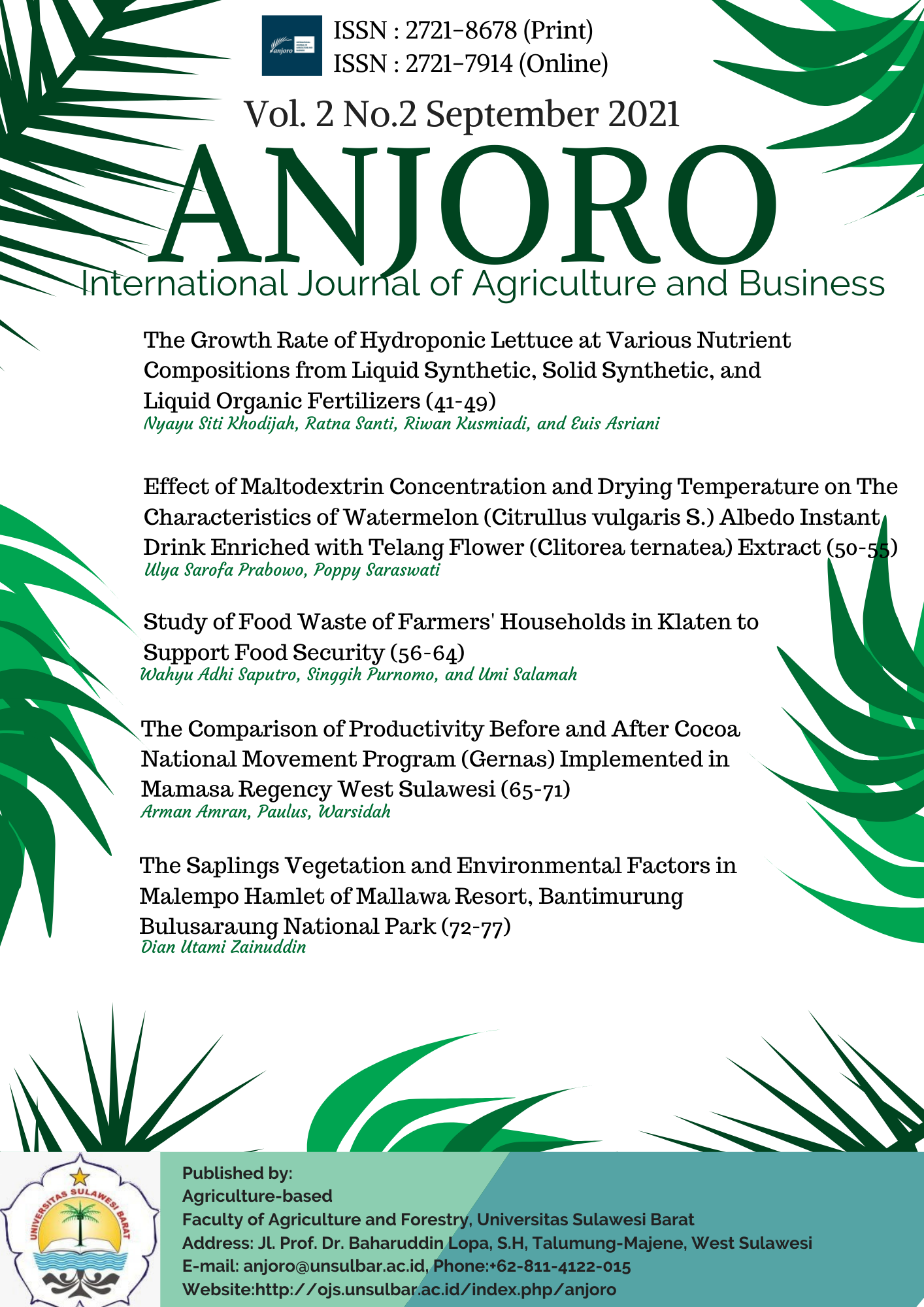Main Article Content
Abstract
In early 1990, Indonesia entered as the third-largest exporter in the world after Ivory Coast and Ghana. The number of cocoa farmers is estimated to be 1.4 million households, generally on a small scale, with an area of about two hectares of cocoa. The very high increase in cocoa prices during the economic crisis in the late 1990s contributed significantly to the poverty alleviation of cocoa farming communities, especially those in rural areas. Almost 20 percent of the national cocoa production comes from West Sulawesi Province. The Cocoa National Movement Program (Gernas) in West Sulawesi is a locomotive for community-based development as a holistic, integrated program involving stakeholders to increase productivity and quality and encourage the growth of the cocoa trade and industry. The Central Government subsequently carried it out formed the National Movement for the Improvement of Cocoa Production and Quality. The research showed that there had been a significant increase in cocoa productivity in Mamasa Regency, West Sulawesi, between before the National Movement Program and after its implementation through rejuvenetion, rehabilitation, and intensification programs. Rehabilitation activities are higher than those of rejuvenation and intensification. Rejuvenation increased cocoa production from 342.68 kg.ha–1.year–1 in 2008 to 605.05 kg.ha–1.year–1. Rehabilitation increased cocoa productivity from 332.47 kg.ha–1.year–1 in 2008 to 720.98 kg.ha–1.year–1 and intensification increased cocoa productictivity from 328.27 kg.ha–1.year–1 in 2008 to 531.45 kg.ha–1.year–1 during the program implemented.
Keywords
Article Details
References
- Karim I, Damrah F, Anas, Wulandari E. The perception of local cocoa farmers to the swisscontact program: economics, environment and social dimension. IOP Conf Ser Earth Environ Sci. IOP Publishing Ltd.; 2020.
- BPS Mamasa. Mamasa dalam angka; 2012.
- Herman F, Arsyad M, Karim I, Nurlaela. Performance analysis of cocoa certification program in Polewali Mandar Regency. ANJORO Int J Agric Bus. 2020;1:1–6.
- Dand R. Environmental and practical factors affecting cocoa production. In: the International Cocoa Trade. 3rd ed.; 2011. p. 65–93.
- Danil. Analysis of cocoa production and marketing in Padang Pariaman Regency, West Sumatra Province [thesis]. Bogor: Bogor Agricultural University; 2012.
- Khaeratih R, Karim I, Nurlaela. The The effect of adoption of frequent harvesting, pruning, sanitation and fertilization on increasing cocoa production (case study: Tapango District, Polewali Mandar Regency). ANJORO Int J Agric Bus. 2021;2:19–25.
- Department of Agriculture, Plantation, and Horticulture of Mamasa Regency. Determination of farmer groups to participate in the national cocoa production and quality improvement movement (GERNAS); 2009.
- Maswadi. Agribisnis kakao dan produk olahannya berkaitan dengan kebijakatan tarif pajak di Indonesia. J. Tek. Perkebunan & PSDL. 2011;1(2):23-30.
- Department of Agriculture, Plantation, and Horticulture of Mamasa Regency. Technical guidelines (juknis) for the movement to increase the production and quality of national cocoa cocoa (GERNAS) Mamasa Regency; 2012.
- Jinap S, Hasnol NDS, Sanny M, Jahurul MHA. Effect of organic acid ingredients in marinades containing different types of sugar on the formation of heterocyclic amines in grilled chicken. Food Control. 2018;84:478–84.
- Sugiyono. Metode Penelitian Kuantitatif, Kualitatif, dan R&D. 2nd ed. Bandung: CV. Alfabeta; 2019. 464 p.
- Utomo B, Prawoto AA, Bonnet S, Bangviwat A, Gheewala SH. Environmental performance of cocoa production from monoculture and agroforestry systems in Indonesia. J Clean Prod. 2016;134:583–91.
- Fitriyah I, Hariyati Y. The excellence of cocoa-goat integrated farming in the implementation of zero waste concept. SEAS (Sustainable Environ Agric Sci. 2020;4:162–7.
- Gockowski J, Sonwa D. Cocoa intensification scenarios and their predicted impact on CO₂ emissions, biodiversity conservation, and rural livelihoods in the Guinea rain forest of West Africa. Environ Manage. 2011;48:307–21.
